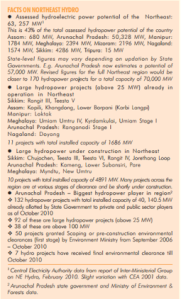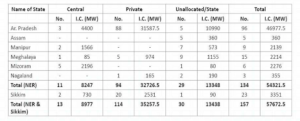By RICHARD KAMEI
Recently a two-day North East People’s Convention on water and dams
was held at Bethesda Youth Welfare Centre, Dimapur (on 17th May-18
th
May 2013) which brought together a group of 26 organisations from North
East India under the banner of the North East Dialogue Forum. This
forum called for a focus into the objectives raised in this two day
convention, by writing to leaders of India, China and Bangladesh over
the imminent adverse impact of the issue of water, impacts of
constructing big dams and mining in various regions of North-East India.
The outcome of this two-day North East People’s Convention on water and
dams, is the joint appeal known as ‘Dimapur Declaration’. At the time
of this declaration, prime address was made to the Prime Minister of
Bangladesh, Sheikh Hasina; the Premier of China, Li Keqiang and Prime
Minister of India, Dr Manmohan Singh. The main objectives of Dimapur
Declaration are: to protect the inherent rights of local people over
their water, land, forest and other resources based on customary and
international laws as guaranteed by the Universal Declaration of Human
Rights and UN Declaration on the Rights of the Indigenous People 2007
etc., and their self-determined development of their water bodies in the
region. The recommendations of the World Commission on Dams, 2000 have
also been given a special mention in terms of its implementation in all
decision making processes on dam constructions over Brahmaputra
(Tsangpo) River. “The Thatte-Reddy Expert Committee said the present
hydropower work on Subansiri contravenes the basic premise of the
Brahmaputra Board Act with regard to flood control, irrigation and other
benefits. The report agreed that the present planning of the project
ignored the flood control aspect. Therefore, the committee agreed that
the very purpose of the project and purpose of the Brahmaputra Board Act
is defeated and the mandate of the board diluted by this action,”
opined Akhil Gogoi, Krishak Mukti Sangram Samiti ( KMSS).
Similarly, sometime in mid June 2013, numbers of anti-dam protestors
of north-east came together at Mairang, West Khasi Hills, supporting the
Indigenous Biodiversity and Social Welfare Organisation (IBSWO)
campaign against the Assam Government intention to construct a dam on
River Khri (called Dron River in Assam) in Meghalaya. This surge of
protest is due to the aggression of hydro-electric projects coming up in
Northeast India at an unprecedented rate under the over-used term
called ‘development’. The concern raised is not only about displacement
of people and the impact on livelihood; there is equitable threat to the
environment which will make it prone to frequent flood, landslides etc.
Moreover, Northeast India lies in an active seismic zone marked by
fragile erosion-prone mountains and a river laden with silt.
The Northeast India fell under the eyes of policy makers post
liberalisation and with its rich natural resources the region is known
to be prioritised for hydro power projects. Thereon, the Central
Government policies allowed states to have a stake in hydro power
projects, and the entrants of private players in the hydro power
projects will put this developmental project at the cost of the
indigenous people and environment.
According to Central Electricity Authority (CEA) study of Brahmaputra
basin in 2001, 168 hydro power projects has been identified amounting
to an estimated capacity of 63,328 MW and with that, it has been termed
as ‘future powerhouse of the country’
. Concurrently in due times,
many similar projects got sanctioned and the rush of this interest
reeks of a vested interest going against the rights of indigenous people
and in disregarding the ecology of the region. Critical to mention of
the ‘future powerhouse’ tag christened upon north east India since the
Northeast Business Summit in Mumbai in July 2002, as the tag is
suggestive of exploitation. It is also important to take note of the
50,000 MW Hydro Initiative launched by the Ministry of Power in 2003 as
its important focus is on the northeast region.
 Source: ‘Damming Northeast India’ by Neeraj Vagholikar & Partha J. Das
Source: ‘Damming Northeast India’ by Neeraj Vagholikar & Partha J. Das
The implication of this policy is first seen in Sikkim in 2001-2002
and the process spreads to other regions of northeast India. Sikkim and
Arunachal Pradesh are the first states from northeast India to sign
multiple Memoranda of Understanding/Agreement (MoU/MoA) with private
players and later on, the similar process is embraced by Meghalaya,
Manipur, Mizoram, Nagaland, Assam and Tripura. There are huge monetary
advances from private companies in all these MoU/MoA for hydropower
projects which took place at the time of sealing the deals and this
happened before any clearance of environment, consultations with
stakeholders, detailed report of project and other mandatory clearances.
The document of Department of Power, Government of Arunachal Pradesh,
mentions of the monetary advances received in the form of processing
fee, upfront premium etc. in the year 2010, for Hydro Electric Projects.
There is huge revenue of money accrued from 186 Memorandum of
Understanding (MoUs) and Memorandum of Agreement (MoAs) between the
state government and big corporate houses such as Jaypee, Jindal,
Reliance, GMR and others. Going by the claims of the Government of
Arunachal Pradesh, if these hydro electric projects are implemented, it
will generate a power of more than 70,000 MW and expected to generate
revenue of more than Rs 10,000 crores every year. The Government of
Arunachal Pradesh is said to have collected more than Rs 1,333 crores
from the private companies; affirming of the huge stakes from private
players in setting up hydro power projects.
 Source: Ministry of Power, Annual Report 2011-2012, “Projects
identified for implementation in N.E. region & Sikkim which are yet
to be taken up for construction for benefits during 12th Plan and beyond.”
Source: Ministry of Power, Annual Report 2011-2012, “Projects
identified for implementation in N.E. region & Sikkim which are yet
to be taken up for construction for benefits during 12th Plan and beyond.”
The might of the interests of private companies is reflected in the
performance audit report of Comptroller and Auditor General (CAG) on
capacity expansion of Hydro Power Sector by Central Public Sector
Enterprises (CPSEs), Ministry of Power (Report No 10 of 2012-13), where
it revealed that Arunachal Pradesh government allotted six projects to
NHPC to generate 20,700 MW by constructing 168 dams to generate 63,300
MW. The turn of this ambitious programme is that four of these six
projects were allotted to private parties between 2006-2010, without any
tender or competitive bidding process.
It is also important to take note of the coming in and the growth of
cement industry in northeast region of India at a time when there is an
onset of the construction of dams. This linkage can be arrived at the
Report of the Working Group on Cement Industry for the XII Five Year
Plan 2012-2017 of Planning Commission where twenty-three percent of the
cement production in India is directly linked to irrigation or the
construction of dams and canals.
Hydro power projects need to pass through mandatory ‘environmental
clearance’ procedures, administered by the Ministry of Environment and
Forests (MoEF), to evaluate their viability on environmental and social
grounds. The geographical location of Northeast needs other clearance
such as ‘forest clearance’ from MoEF and then a separate set of approval
from the Standing Committee of the National Board for Wildlife (NBWL)
for locations inside or within 10 km radius of wildlife protected areas
(PAs). There is also one critical document that aids the decision-making
which is in the form of Environmental Impact Assessment (EIA) report.
According to a February 2013 study by the South Asia Network on Dams,
Rivers and People (SANDRP), a Delhi-based anti-dam organisation: the
hydel environmental assessment committee (EAC) housed in the MoEF, has
evaluated 262 hydropower plants and irrigation projects of India in six
years and surprisingly none got rejected. This prospect is alarming when
many similar projects are coming up in Arunachal Pradesh and other
parts of Northeast India.
Researchers and activists have pointed out that there is a bigger
concern which even in cases of the Environmental Impact Assessment (EIA)
submitted to Ministry of Environment and Forest (MoEF), ignored the
fact that the Brahmaputra region and the whole northeast region, lie in
the active seismic zone when there is a past experiences of several
major earthquakes. This is undeniable concerning the topography and
ecology of the region.
The CAG report [Capacity Expansion in Hydro Power Sector by CPSEs for
the year ended March 2012; Report No 10 of 2012-13 (Performance Audit)]
says that even in projects of NHPC in Siang and Subansiri multipurpose
projects in Arunachal Pradesh, there are lapses in the survey,
assessment of the region, and in not following proper norms and
guidelines. These processes go against the policy of Hydro Power
Development of GOI (1998) that hinges on Detailed Project Report (DPRs)
through investigation, survey and assessment using scientific methods.
This aggression of hydro power projects in northeast has led to a
number of groups opposing to this project. There are various concerns
raised by opposing groups. The hydro power projects overlook at people
living in both the upstream and downstream of the river basins, who rely
on rivers as a part of their lives on being economically dependent for
sustenance, also serving as an integral part of their socio-cultural
life. Moreover other impact that will come along with this project, are
displacement of indigenous people, loss of fisheries in the river,
changes in the wetland, agriculture activities, blockage of river by
dam, vulnerability of flood, etc.
Another feature that needs a focus on the most likely impact of
livelihood has to be shifting agriculture (jhum) which is embraced as a
dominant traditional land use in the hills of northeast India.
For
several periods, jhum plays a critical role in the livelihoods of
people, maintaining agricultural biodiversity and providing food
security. The advent of hydro power projects will push the practice of
jhum to a brink resulting in the shortening of jhum cycles, casting a
risk of its impact on the ecological viability of the farming system.
Similarly the jhum cycle will also be shortened due to the submergence
of land by hydel projects. Add to that, the environment and the
livelihoods of jhum dependent communities will be affected by and large,
and then there will be land use restrictions in the catchment area of
the reservoir as per mandatory norms so as to reduce siltation and to
keep a check on the life of the reservoir.
The provision of Sixth Schedule covered in Northeast India, is
concentrated in the tribal areas of Assam, Meghalaya, Mizoram and
Tripura. The rest of northeast region falls outside the provision of
Sixth Schedule which empowers tribal community their own voice over
their resources. Anti-dam protestors see this as an important tool to
thwart hydro power projects. At the same time, there is a loophole in
the Sixth Schedule where state can override the rights of the tribal
people under special case; for instance the existence of mining, cement
and limestone industries in Meghalaya
. The same holds true for
Forest Rights Act, 2006 where the state can overturn the existing
provision by exerting their influence in overriding the rights of
indigenous people.
The environment and livelihood of people from Northeast India, are
under threat; more so when the whole region falls under active seismic
zone. A bigger disaster will be triggered anytime soon if this expansion
of hydro power project is not checked. The anti-dam protestors have a
huge task to arrive at an amicable solution with the state and other
stakeholders, to which the rights of the indigenous people need to be
placed before the term ‘development’. Even if there is a need for the
hydro power projects, the consent should come from the local community.
Now that the Government of India has aggressively spearheaded the Look
East Policy, the term ‘development’ will be abused further and will
leave no stone unturned to ensure that these mega hydro power projects
are needed to further this policy, under the falsified message of
developing the life of people. Testimonial to this, are the series of
recent developments from Manipur (the pinnacle of Look East Policy) –
the soon to be international airport of Imphal, the easing of movement
of people from both sides at Moreh- small town of Manipur at
India-Myanmar border, the recent Chakpi Dam controversy overriding
indigenous people’s consent, the proposed trilateral highway connecting
India, Myanmar and Thailand, direction from the centre to Manipur to
provide electricity to Myanmar etc. The interests from private companies
will increase in manifold and the rich natural resources of northeast
will face the same narrative that the world has been witnessing time and
again, coupled with man-made natural disasters.
 Oil
India Ltd said today it plans to invest Rs 12,000 crore in the North
East by 2017 on projects, including expansion of exploration work and
diversification of business.
Oil
India Ltd said today it plans to invest Rs 12,000 crore in the North
East by 2017 on projects, including expansion of exploration work and
diversification of business.














